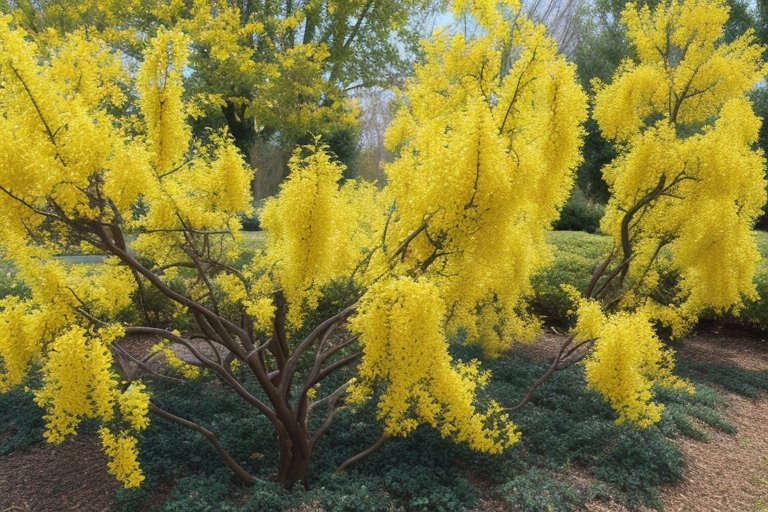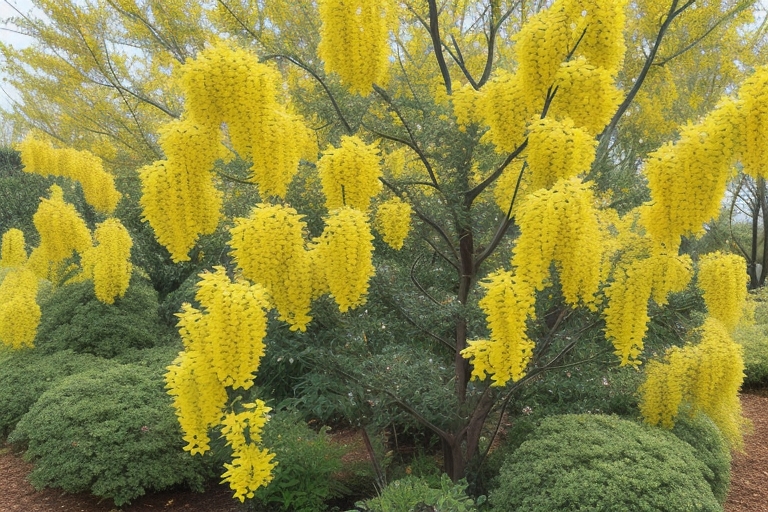Forsythia, with its vibrant yellow blooms, is a beloved shrub that many gardeners enjoy adding to their landscape. Propagating Forsythia is a rewarding way to expand your garden and share the beauty of this plant with others. In this blog post, we will explore the process of How to Propagate Forsythia, from understanding the plant to identifying the best time for propagation. We will discuss the tools and materials you will need, provide a step-by-step guide to propagating Forsythia, and offer tips for troubleshooting common propagation issues. Whether you are a seasoned gardener or a beginner looking to try your hand at plant propagation, this guide will help you successfully propagate Forsythia in your own garden.
Forsythia: Understanding the Plant
Forsythia, scientifically known as Forsythia spp., is a deciduous shrub that belongs to the Oleaceae family. This stunning plant is native to East Asia and is well-known for its vibrant yellow flowers that bloom in early spring. It is a popular choice for gardens and landscapes due to its ability to add a burst of color and beauty during the drab winter months.
Forsythia shrubs typically grow to a height of 6 to 10 feet (1.8 to 3 meters) and have an upright, arching form. The leaves are simple, opposite, and serrated, with a dark green color. The true star of the show, however, is the profusion of bright yellow flowers that cover the branches in early spring before the foliage emerges.
Also Read | How To Harvest Swiss Chard: Easy Step-by-Step Guide
Understanding the growth habit and characteristics of Forsythia is essential when it comes to propagating this plant successfully. Forsythia is known for its vigorous growth and ability to spread through underground rhizomes, which can lead to the formation of dense thickets. This growth habit makes it an ideal candidate for propagation, as it readily produces new shoots that can be used to start new plants.
Additionally, it is important to note that Forsythia is a hardy plant, able to tolerate a range of soil types and climatic conditions. However, it thrives best in full sun to partial shade and prefers well-drained soil. By understanding these basic facts about Forsythia, you can create optimal conditions for successful propagation and ensure the health and vigor of the new plants.
Best Time to Propagate Forsythia
Propagating Forsythia at the right time is essential for ensuring successful root development and overall plant health. Timing plays a crucial role in the propagation process, as it determines the plant’s ability to establish itself and thrive in its new environment. In this section, we will explore the ideal season for propagating Forsythia and discuss why timing is crucial for successful propagation.
Identifying the Ideal Season
The ideal season for propagating Forsythia is early spring, just before the plant starts to produce new growth. This typically occurs in late winter or early spring, depending on your location and climate. Propagating during this time allows the plant to take advantage of its natural growth cycle, making it more receptive to rooting and establishing new plants.
Why Timing is Crucial for Successful Propagation
Timing is crucial for successful propagation because it aligns with the plant’s natural growth patterns. During early spring, Forsythia is in an active growth phase, preparing to bloom and produce new foliage. At this stage, the plant has ample energy reserves stored in its stems, which can be utilized for root development.
By propagating Forsythia during this time, you can take advantage of the plant’s natural vigor and promote healthy root growth. The stems used for propagation will have the highest concentration of growth hormones, which are responsible for stimulating root development. This increases the chances of successful rooting and ensures the establishment of healthy, robust plants.
Furthermore, propagating Forsythia during early spring allows the new plants to benefit from the optimal growing conditions of the upcoming season. As the weather warms up and daylight hours increase, the plants will have ample sunlight and warmth to support their growth. This helps the newly rooted cuttings to establish themselves quickly and develop strong root systems.
In the next section, we will discuss the essential tools and materials needed for propagating Forsythia, ensuring that you are well-prepared for the propagation process.

Tools and Materials Needed for Propagation
When it comes to propagating Forsythia, having the right tools and materials is crucial for ensuring successful propagation. In this section, we will discuss the essential tools, the best soil mix for Forsythia, and choosing the right container for propagation.
List of Essential Tools
- Pruning Shears: High-quality pruning shears are necessary for taking stem cuttings. Ensure that your shears are clean and sharp to make clean cuts, promoting optimal rooting.
- Rooting Hormone: Rooting hormone is a valuable tool for promoting root development in cuttings. Look for a hormone specifically formulated for woody plants like Forsythia.
- Sterile Cutting Tool: A sterile cutting tool, such as a scalpel or a razor blade, is useful for making precise and clean cuts on the stem.
- Spray Bottle: A spray bottle filled with water is handy for misting the cuttings to maintain a humid environment during the rooting process.
- Labels: Using labels to identify the different varieties or stages of propagation is essential for keeping track of your cuttings.
Best Soil Mix for Forsythia
Forsythia thrives in well-drained soil that is rich in organic matter. To create the best soil mix for propagating Forsythia, consider the following components:
- Peat Moss: Peat moss helps retain moisture in the soil mix while providing good aeration.
- Perlite: Perlite improves drainage and prevents the soil from becoming compacted.
- Vermiculite: Vermiculite retains moisture and aids in root development.
- Compost: Adding compost to the soil mix enriches it with nutrients and organic matter, promoting healthy growth.
Mix these components in equal parts to create a well-balanced soil mix for your Forsythia cuttings.
Choosing the Right Container
When it comes to choosing a container for propagating Forsythia, consider the following factors:
- Size: Select a container that is large enough to accommodate the root system of the cuttings comfortably. A container with a depth of at least 6 inches (15 cm) is recommended.
- Drainage: Ensure that the container has adequate drainage holes to prevent waterlogging, which can lead to root rot.
- Material: Choose a container made of a durable and non-porous material, such as plastic or terracotta. Avoid containers made of metal, as they can heat up quickly under sunlight and potentially harm the developing roots.
By having the essential tools, the right soil mix, and a suitable container, you will be well-equipped for successful Forsythia propagation. In the next section, we will provide a detailed step-by-step guide to propagating Forsythia, taking you through the entire process from preparing the stem cuttings to caring for the propagated cuttings.
Step-by-Step Guide to Propagating Forsythia

How to Propagate Forsythia
Propagating Forsythia is an exciting and rewarding process that involves taking stem cuttings and encouraging them to develop roots. In this section, we will provide a step-by-step guide to help you successfully propagate Forsythia in your garden.
Preparing the Stem Cuttings
- Select Healthy Parent Plant: Choose a healthy, mature Forsythia plant as the source for your stem cuttings. Look for a plant with vigorous growth and vibrant foliage.
- Timing: As mentioned earlier, the ideal time to take stem cuttings is in early spring, just before the plant starts to produce new growth.
- Cutting Selection: Identify and select strong, non-flowering stems that are approximately 6 to 8 inches (15 to 20 cm) in length. These stems should be free from any diseases or damage.
- Cutting Technique: Using clean, sharp pruning shears, make a clean diagonal cut just below a node (the point where a leaf or bud emerges from the stem). This will maximize the surface area for rooting.
- Leaf Removal: Remove the lower leaves from the stem, leaving only a few leaves at the top. This reduces moisture loss and directs the plant’s energy towards root development.
Planting the Cuttings
- Rooting Hormone Application: Dip the cut end of each stem into a rooting hormone powder or gel to promote root development. Follow the instructions on the product label for proper application.
- Potting Mix: Prepare a well-draining potting mix using the components mentioned in the previous section. Fill a container with the potting mix, leaving enough space to accommodate the cuttings.
- Planting: Make a hole in the potting mix using a pencil or your finger. Insert the cut end of the stem cutting into the hole, ensuring that at least one or two nodes are buried in the soil. Gently press the soil around the cutting to provide stability.
- Watering: Water the newly planted cuttings thoroughly to settle the soil and provide moisture. Avoid saturating the soil, as excessive moisture can lead to rotting.
- Humidity Control: To maintain a humid environment around the cuttings, cover the container with a clear plastic bag or place a plastic dome over it. This helps to retain moisture and promotes successful rooting.
Caring for the Propagated Cuttings
- Light and Temperature: Place the container in a location with bright, indirect light. Avoid direct sunlight, as it can scorch the delicate cuttings. Maintain a consistent temperature between 65°F to 75°F (18°C to 24°C) for optimal growth.
- Watering: Monitor the moisture level in the potting mix and water the cuttings when the top inch of soil feels dry. Be careful not to overwater, as it can lead to root rot. Mist the cuttings regularly to maintain humidity.
- Transplanting: After 8 to 10 weeks, check for root development by gently tugging on the cuttings. If you feel resistance, it indicates that roots have formed. At this stage, you can transplant the rooted cuttings into individual pots or directly into the garden.
- Harden Off: Before transplanting the rooted cuttings outdoors, gradually expose them to outdoor conditions over a period of a week or two. This process, known as hardening off, helps the plants acclimate to the outdoor environment.
By following this step-by-step guide, you can successfully propagate Forsythia and enjoy the beauty of these vibrant shrubs in various areas of your garden. In the next section, we will discuss common propagation issues and provide tips for troubleshooting to help you overcome any challenges that may arise.
Troubleshooting Common Propagation Issues

While propagating Forsythia can be a rewarding process, it is not without its challenges. In this section, we will address common propagation issues that you may encounter and provide tips to troubleshoot and overcome these challenges.
Identifying Common Problems
- Root Rot: Excessive moisture or poor drainage can lead to root rot, which is characterized by a foul odor and mushy roots. This can occur if the potting mix is too wet or if the container lacks proper drainage.
- Fungal Diseases: Forsythia can be susceptible to fungal diseases such as powdery mildew or leaf spot. These diseases manifest as white or gray powdery growth on leaves or dark spots on foliage.
- Lack of Rooting: Sometimes, cuttings may fail to root due to various factors such as improper cutting selection, inadequate moisture, or insufficient rooting hormone application.
Tips to Overcome Propagation Challenges
- Prevention is Key: Ensure proper sanitation practices by sterilizing cutting tools before use. Use clean containers and fresh potting mix to minimize the risk of fungal diseases.
- Improve Drainage: If root rot is an issue, check the drainage of the container. Repot the cuttings in a well-draining potting mix and ensure that the container has drainage holes.
- Adjust Moisture Levels: Avoid overwatering by allowing the top inch of soil to dry out before watering again. Mist the cuttings instead of drenching them to maintain humidity without waterlogging.
- Provide Air Circulation: Increase airflow around the cuttings by removing any plastic covering or dome once roots start to develop. This helps prevent the development of fungal diseases.
- Use Fungicides: If fungal diseases like powdery mildew or leaf spot appear, treat the affected plants with appropriate fungicides following the instructions on the product label. Remove and dispose of any severely infected plant material.
- Review Propagation Techniques: If cuttings are not rooting, review your cutting selection, hormone application, and environmental conditions. Ensure that you are following the recommended guidelines for successful propagation.
By being proactive and taking the necessary steps to prevent and address common propagation issues, you can increase the chances of successfully propagating Forsythia. Remember that each propagation attempt is a learning experience, and with practice, you will become more adept at troubleshooting and achieving successful results.
In conclusion, propagating Forsythia allows you to expand your garden and share the beauty of this vibrant shrub with others. By understanding the plant, identifying the best time for propagation, using the right tools and materials, following a step-by-step guide, and troubleshooting common issues, you can confidently propagate Forsythia and enjoy the rewards of your gardening efforts. Happy propagating!
